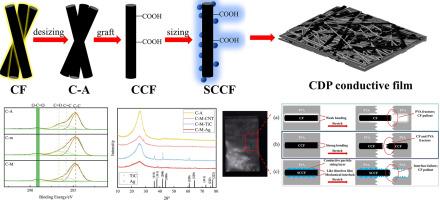Fabrication of high-performance flexible conductive carbon fiber films via two-step mild synergistic surface modification
IF 6.3
2区 材料科学
Q2 CHEMISTRY, PHYSICAL
引用次数: 0
Abstract
This study employed a two-step mild synergistic modification for carbon fibers (CF) and, subsequently, solution casting to fabricate a flexible CF/DPWF/PVA conductive film with excellent performance from carbon fibers, digital printing waste paper fibers (DPWF), and polyvinyl alcohol (PVA). The results demonstrate that the grafting treatment with Meldrum's acid and maleic acid causes negligible damage to CF properties, while the carboxyl group content on CF surfaces increases by over 50 %, enhancing the interfacial bonding between CF and PVA matrix and thereby significantly improving the electrical conductivity and mechanical properties of the films. After adding carbon nanotubes, nano-TiC, and micron-sized silver powders, the thermal stability of CF decreases, while its specific surface area expands. The presence of conductive particles enhances the film's electrical conductivity; however, poor interfacial bonding with CF partially compromises the mechanical properties. Compared to unmodified conductive films, the modified films exhibit stronger bonding between CF and the PVA matrix, while the maximum improvement in electrical conductivity exceeds 200 times, and a maximum tensile strength improvement exceeding 40 %. This study provides valuable insights for CF surface modification strategies and the extended applications of CF/digital printing waste paper composites.

两步温和协同表面改性制备高性能柔性导电碳纤维薄膜
本研究以碳纤维、数码印刷废纸纤维(DPWF)和聚乙烯醇(PVA)为原料,采用两步法对碳纤维(CF)进行温和的协同改性,然后进行溶液铸造,制备出具有优异性能的柔性CF/DPWF/PVA导电膜。结果表明:麦德伦酸和马来酸接枝处理对CF性能的破坏可以忽略,而CF表面羧基含量增加50%以上,增强了CF与PVA基体之间的界面键合,从而显著提高了薄膜的导电性和力学性能。添加碳纳米管、纳米tic和微米级银粉后,CF的热稳定性降低,比表面积增大。导电颗粒的存在增强了薄膜的导电性;然而,与CF的界面结合不良部分影响了力学性能。与未改性的导电膜相比,改性后的导电膜与PVA基体之间的结合更强,导电性能最大提高超过200倍,抗拉强度最大提高超过40%。该研究为CF表面改性策略和CF/数字印刷废纸复合材料的扩展应用提供了有价值的见解。
本文章由计算机程序翻译,如有差异,请以英文原文为准。
求助全文
约1分钟内获得全文
求助全文
来源期刊

Surfaces and Interfaces
Chemistry-General Chemistry
CiteScore
8.50
自引率
6.50%
发文量
753
审稿时长
35 days
期刊介绍:
The aim of the journal is to provide a respectful outlet for ''sound science'' papers in all research areas on surfaces and interfaces. We define sound science papers as papers that describe new and well-executed research, but that do not necessarily provide brand new insights or are merely a description of research results.
Surfaces and Interfaces publishes research papers in all fields of surface science which may not always find the right home on first submission to our Elsevier sister journals (Applied Surface, Surface and Coatings Technology, Thin Solid Films)
 求助内容:
求助内容: 应助结果提醒方式:
应助结果提醒方式:


